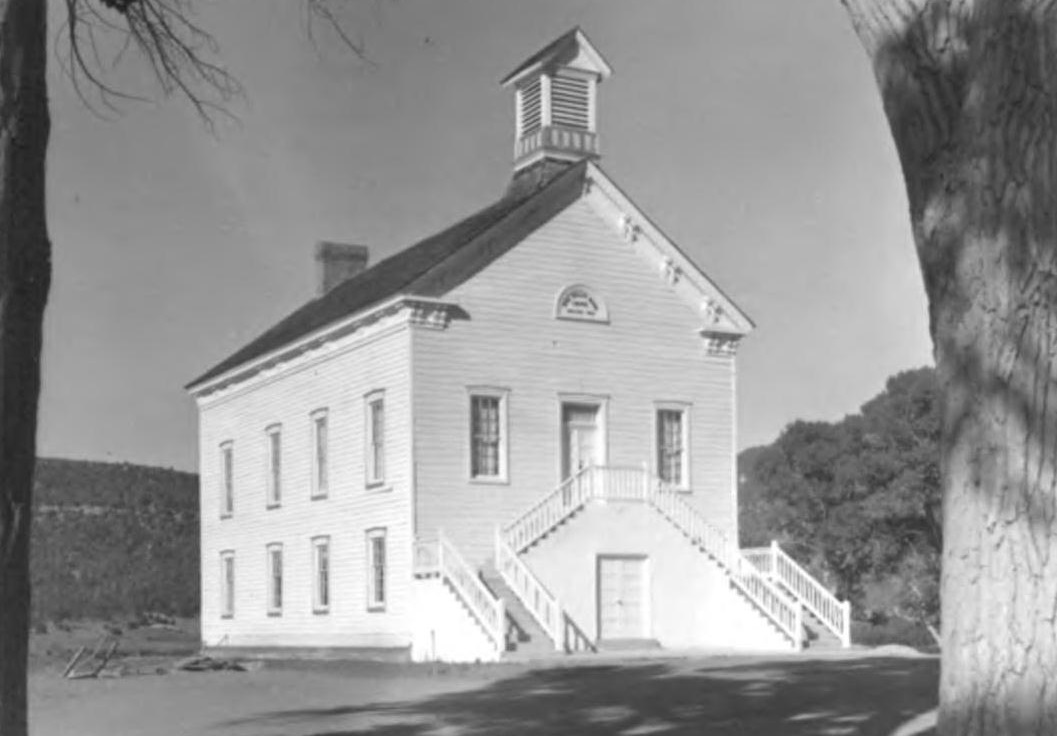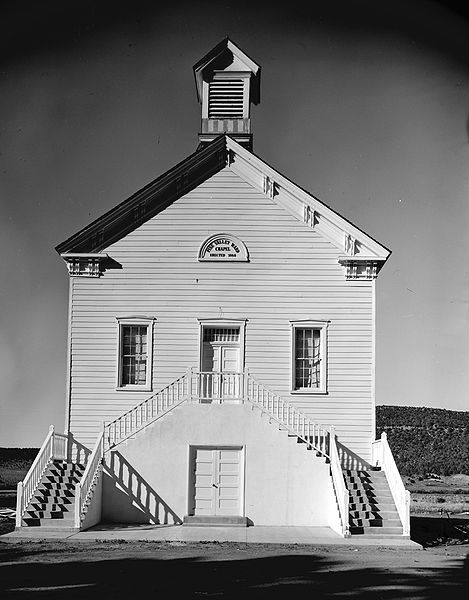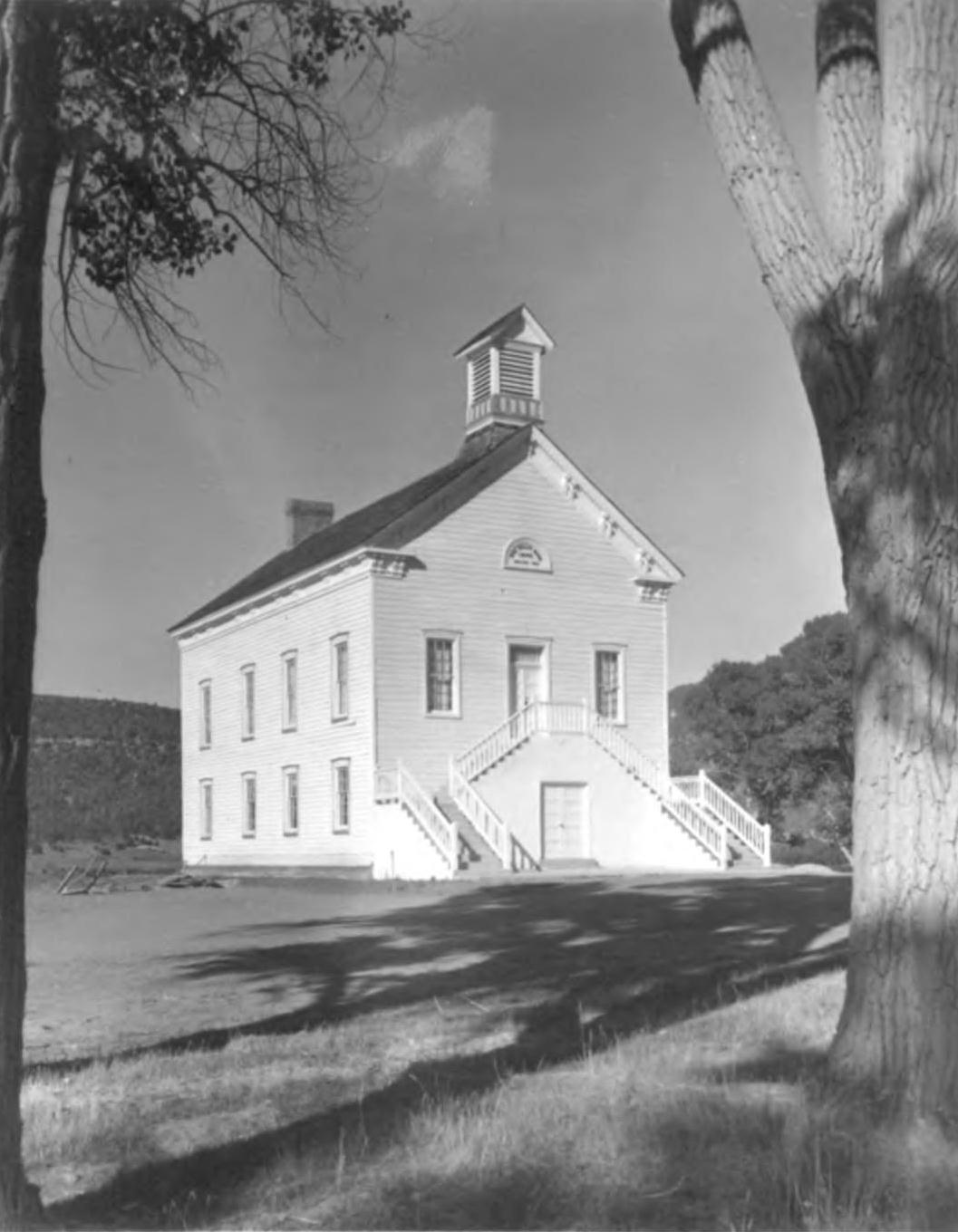
WASHINGTON COUNTY HISTORICAL SOCIETY (Washington County, Utah)
PINE VALLEY CHAPEL
Pine Valley, Utah
LOCATION
52 W. Main Street (at Grass Valley Street)Pine Valley, UT 84781
(801)231-5321
37° 23' 30.47" North Latitude, 113° 30' 52.76" West Longitude
37.3918° North Latitude, 113.5147° West Longitude
x,xxx feet (xxx meters) MSL
Open for tours beginning again on May 28, 2021:
1:00-5:00 pm on Mondays and Wednesdays
10:00-5:00 pm on Mondays following a holiday weekend
10:00-5:00 pm on Fridays and Saturdays
HISTORY
The settlers of the Pine Valley logging and saw-milling community wanted to build a church that would also function as a school and community building. Ebenezer Bryce was approached to design and supervise the construction. The chapel was constructed of local pine and set on a foundation of granite and red limestone. Since Bryce's experience was as a shipbuilder, the attic of the building is essentially a ship's hull turned upside down. Each of the walls was constructed flat on the ground, then lifted up and tied at the corners with strips of rawhide. The chapel was completed in 1868. Bryce later moved to Garfield County and Bryce Canyon National Park was named after him in the 1920's.The Pine Valley Chapel and adjacent Tithing Office was listed on the National Register of Historic Places (#1971000859) on April 16, 1971.
The Pine Valley Chapel is still used for services and is the oldest Mormon chapel still in continuous use. Services are held year-round on Sundays and often host large crowds. If the capacity of the building is exceeded during the summers, attendees can be seated on the lawn and watch the televised service.
Commentary by Mary Phoenix:
The Pine Valley Chapel has the distinction of being the oldest church in Utah in terms of use, for it has continuously served as a church since its erection in 1868. Fortunately, those in charge of this architectural gem have maintained it well and have insisted that necessary repair work alter the building very little, if at all.
Accounts tell how in 1855 Isaac Riddle, searching for a lost cow, stumbled onto a beautiful valley with a stand of prime timber, and soon the sawmill and the town were born. About 1868 it was decided to move the little settlement farther down the canyon to where there was more arable land and where it was easier to irrigate. These people decided that they needed a building for church and school purposes before they needed homes.
The raw material was plentiful. Granite boulders, huge hunks of limestone, and an abundance of timber was readily available but they lacked an architect, or master builder as they were called then.
Ebenezer Bryce, discoverer of Bryce Canyon, had been trained as a shipbuilder in his native Australia [Correction: He was born in Scotland]. When he arrived in Pine Valley with a herd of cattle, William Snow, bishop of Pine Valley, approached him about designing and supervising the construction of a church building. Bryce finally agreed if they were willing to accept his design of an upside down boat .
Local stone was used for the basement and foundation. The finest trees in the valley, from the same stand as those from which the pipe organ in the Salt lake Tabernacle was constructed, were selected for lumber and cut and shaped by hand since the logs were too large for the Pine Valley sawmills to handle.
The frame, measuring 33'3" by 54'4", was put together with wood pegs and bound with green hides which became strong as steel when dried. It was constructed on the ground and then every man, boy and animal was enlisted to tug it upright so the walls could be affixed.
The building has two stories. The bottom was used for school and recreational functions and the second floor was the chapel. Immediately over the dais is a small prayer room. The attic, which visitors may view, is interesting for the ship-type riggings used there.
When travellers enter the serene Pine Valley and see the white chapel commanding the landscape, they are reminded of the words spoken by Ebenezer Bryce at the dedicatory ceremony. "If the floods come, it will float. If the winds come, it may roll over. It will never crash." After one century and almost a quarter of another we realize how truly prophetic his words were.
PHOTOS
 South/front side of the building |
 South/front & west sides (Kent Fairbanks, 4/16/1971) |
WCHS photos:
WCHS-00543 Jon Bowcutt sketch of the Pine Valley Chapel
WCHS-00707 6th annual Pioneer Courthouse Invitational Art Exhibit poster
Other photos on the web:
Old photo of the Pine Valley Chapel
Old photo of the Pine Valley Chapel
Old photo of the Pine Valley Chapel
1973 photo of the Pine Valley Chapel
Old photo of the Pine Valley Chapel
Old photo of the Pine Valley Chapel
1968 photo of the Pine Valley Chapel
Old photo of the Pine Valley Chapel
Old photo of the Pine Valley Chapel
Photo of the Pine Valley Chapel from a distance
Roland Lee painting of Pine Valley Chapel
Roland Lee painting of Pine Valley Chapel
Photos from the National Register of Historic Places nomination form
REFERENCES
Official website of the Pine Valley ChapelWebsite of the Pine Valley Chapel and related subjects
Description of the Pine Valley Chapel with photos
Description of the Pine Valley Chapel with photos
Pine Valley Chapel pictures
National Register of Historic Places, Inventory - Nomination Form
Historical Buildings of Washington County (Volume 1), pp. 8-9.
SOUTHERN UTAH MEMORIES: The Founding of Pine Valley
by Loren R. Webb, August 7, 2012